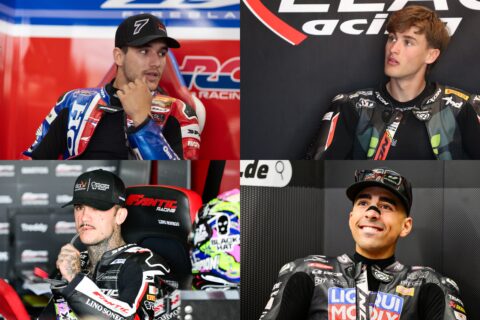A constant stream of visitors tackle the steps leading to the twin grey towers of IRTA. This is the MotoGP paddock at Silverstone and their stern appearance is in sharp contrast to the gaudiness of the racing trucks that seem to stretch for miles either side. But this where the business of the International Racing Teams Association is conducted.
Inside sits the supremo and founder of IRTA, Mike Trimby, and his wife Irene. For more than thirty years they have represented the teams in Grand Prix racing and are members of a powerful quartet which controls the sport, including Dorna, owners of the commercial rights, the most valuable part; and the FIM, the governing of motorcycle sport world wide. Alongside them is the MSMA, dominated by the Japanese manufacturers.
Everything inside the paddock gates, but not on the track, is controlled from here. Up the steps troop team bosses, riders, race organisers, media. All wanting information, advice and, very likely, passes. Irene, in the office on the left, dispenses these in her cheery but efficient way, together with the odd cup of tea for the very privileged.
The office on the right is where Trimby holds court. A patrician-like but amiable figure, it is difficult to imagine him as a racer. But that’s what he was, starting by working as a mechanic for Syd Lawton and in the mid-sixties, early seventies, racing with some degree of success in UK meetings including the Isle of Man where he now lives.
But his spirit for adventure took him to places like Daytona and Macau, which also kindled the entrepreneurial urge. He was by now a marketing manager for Smith & Nephew, manufacturers of Elastoplast, but quit with the idea of running trips to those far-off places and in 1978 was asked to organise entries for Macau, a job he continued doing until 2011. He also launched the Racing and Sporting Show at Alexandra Palace which he then sold to EMAP, publishers of MCN, in the nineties.
But the rise and rise of Trimby as a major force in the world of Grand Prix racing came following a long period of rider unrest in the early eighties, an attempt by Kenny Roberts to organise a World Series and a strike at Nogaro. The issues were safety and money. Trimby was well connected by that time and at a GP riders’ meeting at Donington in 1982 he was asked to represent them. Four years later IRTA was born, morphing from a riders’ trade union to a body representing the teams. This was the start of a period of huge change for Grand Prix racing and an unprecedented power struggle.
The FIM still controlled pretty much everything but then allowed IRTA and ROPA, the circuit owners, to market the television rights. They invited Bernie Ecclestone, already holder of the TV rights for F1, to help them. But when, in 1992, the FIM decided to cancel the contract and award the TV rights to Dorna, war was declared.
“This pissed Bernie off and it certainly pissed us off,” said Trimby. “So Bernie, who had been courting us anyway for about three or four years, said ‘Right, that’s it, we’re going to break away from the FIM and run our own championship’.”
That was Plan ‘A’. What emerged was Plan ‘B’ where Ecclestone obtained the commercial rights which he sold to Dorna for £50million. Now it was surely Trimby and IRTA and everybody else who were pissed off? Hadn’t they been legged over by the wily ex-racer and he surely could not be Trimby’s favourite person?
“No, not at all,” said Trimby. “He’s not my favourite person. But without Bernie it wouldn’t have happened, Without the clout that Bernie had and the ability to negotiate that Bernie had, one against each other, it would never have happened. I don’t think he pulled a fast one, I think he saw things evolving and saw how he could profit from it. And at the same time make everyone happy. The FIM got paid for their rights which they’d never had before - six or seven mill a year or whatever, Dorna got the TV rights which was what they were looking for, Bernie was organising the events and we got a load more money for the teams and the right to define the sporting and technical rules. Everyone was happy.”
Bikesport News: So Mike, 23 years have passed since the ‘Ecclestone Incident’ so what do you see as having changed in that time? What do you think of Grand Prix racing, which has now been rebranded as MotoGP in that time?
Mike Trimby: We have had to manage the transition from a tobacco-dominated sport into the new era. In the latter days of the two-strokes you could virtually knock on any fag company’s door and get huge budgets from people making fortunes. We’ve had to survive the period when that money disappeared. It has not been replaced and we’ve had to look for other sources of income for the teams.
Thankfully, events are still popular and promoters still want to run races for the fees that Dorna charges and this has been helped by the fact that there are more safe circuits. Before we were limited and in the UK we can only go to two circuits, not Brands, Snetterton, Cadwell etc. because they’re not homologated. And the same around the world. But now people are building safe circuits in other parts of the world, which gives Dorna better negotiating power when getting the sanctioning fee.
BSN: But not in Europe?
MT: Yes, we’ve got Finland building a new circuit, Kazakhstan if you call that Europe, and a number of circuits in Spain. Not as bad as F1 where they are dropping like flies. Germany is making a fortune, the two rounds in Italy are very successful, the French GP is successful. Dorna is generating income from them which comes to us.
Individual team sponsorship is hard. They have to rely more on what we pay them, which comes from Dorna, than sponsors. TV is changing. We’re having to move to the pay TV model, like most major sports, and although that reduces the audience it significantly improves the income to Dorna which, again, filters down to us. Event sponsorship is not the golden nugget it was before. So again it is TV, fees from promoters and money we can generate from our own sponsorship efforts. We contract the teams, they contract the riders. There is a set scale of payments and allowances to the teams.
BSN: No preferential treatment like that given to Ferrari in Formula 1?
MT: No. One of the philosophies we had right from the start in 1992 was that we had to pay the person at the back almost more than the person at the front because Honda, Yamaha, Suzuki whatever will be there anyway but they need people to beat. And without the people filling the 15th to 25th places you don’t have a race. Filling the grid has been a problem - it was a huge problem in 1991 when you had 14 or 15 riders on the grid because teams couldn’t afford to go racing on the money the FIM was paying. Now there may be one or two teams almost getting more money than we pay Honda.
BSN: Are there going to be further changes to team funding as you try to level the playing field?
MT: We have already announced that as from 2017 there is a new structure. We have been short of manufacturers and by then we will, hopefully, have six - Honda, Yamaha, Suzuki, Aprillia, Ducati and KTM. Each of those providing two factory bikes for their own use. They then have the possibility of offering these machines to other teams. Each of the independent teams will be paid €2m per entry per season on top of the money that IRTA pays them race by race which will amount to some €800,000 for the year with all the free freight allowances etc.
The Tech 3 team for example will receive €2m per entry. The price of a leased machine is capped at €2.2m including all running parts but not crash parts. And that is the maximum price so Honda cannot, for example, charge more than that, Yamaha the same. But KTM, if they want, can charge €1m or €1.2m. If a team takes what we’re paying them, what that subsidy is and whatever else they can garner from sponsorship etc. they should have a viable operation. And we’ll have 24 factory quality bikes. Now some of them might be last year’s models but they will all be competitive.
BSN: But isn’t there inevitability, as in all sports, that the teams with the most money will still win?
MT: Maybe, because they can hire the best riders and that is worth more than a few horsepower on the bike. Anybody who can afford to hire (Valentino) Rossi or (Marc) Marquez or (Jorge) Lorenzo are going to have an advantage of those with others. They wouldn’t necessarily win on bikes at the back of the grid but they give you an advantage. I don’t know what they’re getting paid but the factories can buy the best riders so they will always have an advantage over those who can’t.
BSN: And what about races? Currently you have 18 and you’re going up to, what, 20 in 2017?
MT: That’s the maximum in the new contract. Our contract with Dorna expires at the end of next year and we’re negotiating a new contract to take us from 2017 to 2021. We didn’t think we could go beyond 18 but we now think 20 is possible because there will be less testing. Testing costs as much as going to a race but produces no income, no media coverage or whatever. But 20 is, we think, about the top.
BSN: Where are these new races going to be? Presumably from countries or regions who can afford them, like Victoria in Australia, which supports F1 and MotoGP. Or where manufacturers need to sell most bikes?
MT: We definitely need more in South East Asia, particularly Indonesia. We already have the potential for a race in Thailand, indeed we might be going there next year. And we have interest from other areas like Kazakhstan, Finland, Brazil.
BSN: There’s quite a few Brits on the grid, would you say there’s almost too many? And do you try to balance out the nationalities?
MT: No, not at all. When we’re selecting teams for Moto3 or Moto 2 we do like to see a diversity of nationalities. Dorna are spending money in Asia for example trying to develop talent and we have the Red Bull rookies. So it is important for television, sponsorship etc. But some circuits will say they don’t care about local talent, all they want is Rossi to sell tickets.
BSN: But that is the same in every sport, it is global stars who pull in the fans. And Rossi, above everyone else is one.
MT: Yes, and we had great hopes of another one, (Marco) Simoncelli, until his tragic accident. But with the exception of Rossi, stars are not everything. Who the hell was Casey Stoner? No one talks about him except a few Luddites saying bring back Casey. Or indeed Wayne Rainey, Kevin Schwantz or Mick Doohan. Times move on. We’ve got a new star in Marquez.
BSN: But Rossi won’t be forgotten for a long time?
MT: No, no. Of course not. Nor Barry Sheene, a superstar.
BSN: So is Rossi the biggest star you have ever known?
MT: No, Mike Hailwood, by a mile. His comeback on the Ducati in 1978 was just outstanding and something really special.
BSN: On the question of levelling the playing field, the control ECU, the new Michelin tyre rules etc., they’re all designed to get closer racing and reduce the cost?
MT: Reduce the cost, yes, and level the playing field to a large extent because you have huge differentials in the capabilities of the factories because even if you give everyone the same basic piece of software Honda, for example, may still hire the best technicians to programme it. But it will give the other teams a better chance of being up there.
Same tyres are a different argument. It had to come. It just wasn’t working where you had races being won depending on bringing the right tyre to the race which was wrong.
BSN: Have you ever considered, like they do in the States, effectively rigging the competition to make racing more interesting. You are in the entertainment business and sport can sometimes be quite boring. British Superbikes, for example, have the Showdown in which the leading riders go back, more or less, to scratch for the last few rounds?
MT: Yes, we are in the entertainment business and I think we do provide very good entertainment without reverse grids, weight penalties etc. We don’t need to because we have very competitive racing.
BSN: Are audiences increasing this year or not?
MT: Hugely. Live spectators at events are up everywhere we have gone this year without exception. Yes, Indianapolis didn’t look huge but when you have a 65,000 crowd in a stadium with 400,000 seats they look lost. Television audiences are down because we have changed our delivery system from free-to-air to pay TV by necessity. In the UK British Telecom are very happy with what they are getting and as they acquire more premier sports then more people will trip over us. We also serve a lot of national broadcasters who are not pay TV.
BSN: And what of the future ownership of Dorna which has changed hands in the past, from one private investment company to another. Won’t it be sold again shortly?
MT: Not necessarily. Bridgepoint who bought it from CVC now has a Canadian pension fund as a large co-shareholder. Many of the businesses they invest in are pretty mundane and MotoGP is exciting and glamourous by comparison. They enjoy it and I don’t think there is the urgency to comply with the normal business model, provided it is making a good return for the investors.
BSN: And finally, as a resident of the Isle of Man, do you take an interest in or even see the racing there. And what do you think of road racing in general?
MT: I don’t watch racing in the Isle of Man because I see enough racing. I did it myself when I was racing and it was the best thing I did. But I have also had so many friends killed and that is what worries me. I respect what they do. The Isle of Man has been extremely clever in repositioning their event. They used to say it was relatively safe because if you compared the miles raced with others it was ok. Now they are saying ‘ok, it’s dangerous. People do get killed here but it’s the ultimate challenge. If these guys want come here and put their lives on the line we should allow them to do it.’ But I still hold my breath every time the races are held.
What is IRTA?
The International Racing Teams Association, as we know it today, was founded in 1986. It evolved from what had effectively been the Grand Prix riders trade union when riders, even those on factory bikes, operated individually with their own mechanics often from the back of a van, to teams.
Much earlier, in the late seventies, there was an attempt by Kenny Roberts to start a World Series independent of the FIM because the riders were getting fed up with poor money from race organisers and dangerous tracks. It didn’t get off the ground because some riders, including Dutch star Wil Hartog, refused to join.
But the unrest continued and in 1982 there was a riders strike at Nogaro because of an overcrowded paddock, among other complaints. This was followed by a meeting of the riders set up by Chris Carter, the founder of BSN, at a Donington International race. Former racer and tour organiser Mike Trimby was called in and asked to represent their interests to organisers, primarily on issues of prize money and safety.
The result was the disappearance of many catch-fences and Armco barriers plus a 40% increase in prize money from the organisers association ROPA.
During this time teams were being formed, both manufacturer and private, and in 1986 the Grand Prix riders union became IRTA, representing the teams which by then employed most of the riders.
The main issues remained money and safety but commercial opportunities, especially television, were arriving and individual contracts negotiated (if at all) by circuits was replaced by central negotiations. Added to this was electronic timing, permanent passes, etc. Grand Prix racing organisation and promotion had changed forever. Hadn’t it?
Not quite. Enter Bernie Ecclestone. A power struggle ensued and by 1992 the game had changed again, as described elsewhere, but this time to stay. Mike Trimby describes the present set-up:
“The championship nowadays is managed by the FIM, Dorna, the MSMA and IRTA within a body called the GP commission which is the rule-setting body for the championship. We have the rights on sporting and safety issues, Dorna have the rights on commercial issues, the MSMA have the rights on certain technical issues and the FIM collect the money.
“We recruit and represent all the teams and riders, ‘sell’ that package to Dorna who pay us each Grand Prix or whatever for that and Dorna own all the commercial rights to the championship.”
So Dorna has all the power? “Yes, they choose the events, they pay the money and we provide the show.”
And has it been an unqualified success over almost 30 years? “Every major sport has had to break away from the men in suits,” says Trimby. “In the old days the racing commission of the FIM consisted primarily of federations but they were also the organisers of the events, feathering their own nest because running a Grand Prix was a very profitable business. They would sit down and decide where the events were going to be, how much the teams/riders were going to be paid with no concern for the participants. That had to be changed.”
The Trimby and Ecclestone Show
By the early nineties television was becoming an important medium particularly as the audience potential was huge and sponsorship money vital to the team’s finances. The governing bodies, such as the FIA and FIM, were slow to recognise the potential and they were happy to take money for the rights. IRTA and ROPA, the circuit owners body, bought them.
But they still had to be sold. Along came an ex-motorcycle and car dealer from Sidcup, Bernie Ecclestone, to do just that. He had by that time acquired the Formula 1 rights from the FIA.
The FIM and it’s road racing commission were still controlling the Grands Prix, including when and where events were, and the prize money which racers had to queue up to collect at the end of the meeting.
In 1991 the FIM went over the heads of IRTA and ROPA and decided to award the television contract to a small Spanish marketing company called Dorna, whose main business was in football. Messrs Trimby and Ecclestone were not happy.
Ecclestone, who had been courting IRTA for some time, suggested they break away and run their own championship with IRTA signing up the teams. Yamaha were the first manufacturer but a conclusive piece in the jigsaw, signing up at the Malaysian GP in Kuala Lumpur. A jubilant Trimby rang Ecclestone who promptly got his sidekick Max Mosley, a lawyer of some repute, to change the statute of the FIA allowing that body to sanction any form of motor sport, other than just four wheels, which made them more powerful than the FIM.
But Bernie had an even bigger and more cunning plan. During this period he had been talking to both the FIM and Dorna, cobbling together a compromise where he owned the commercial rights to the championship, paying the FIM a fee, allowing Dorna to retain the TV rights and IRTA to run the championship.
Trimby and Paul Butler, then Yamaha team boss, spent a weekend re-rewriting a new rulebook aided by Mosley. Everyone got what they wanted, power more evenly distributed and more money for the riders and the FIM. That lasted until 1992 when Ecclestone sold the commercial rights to Dorna for £50 million. He made the most. His plan worked out perfectly. He left behind a few bruised individuals. But everyone was a winner. Especially Bernie.


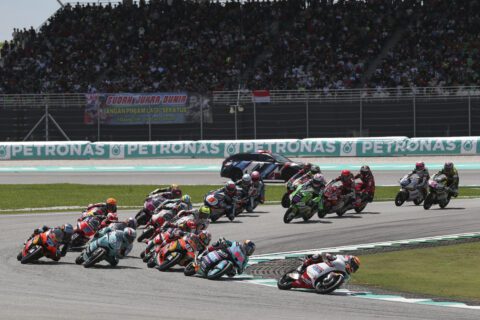
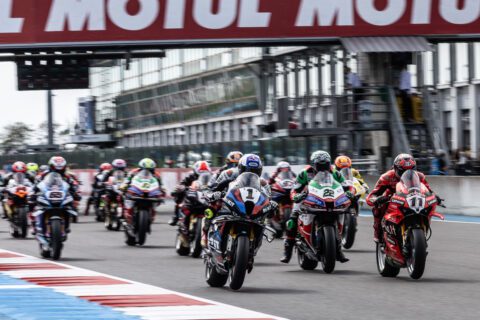
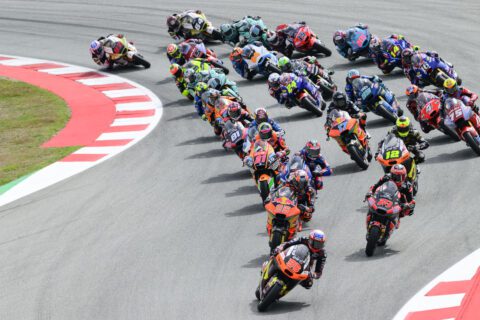
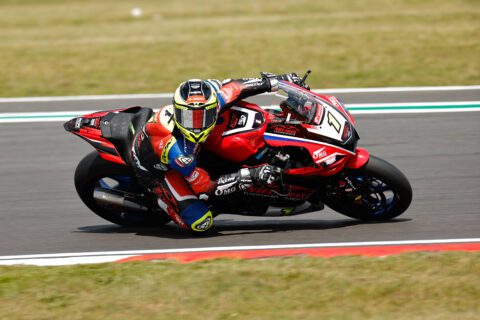
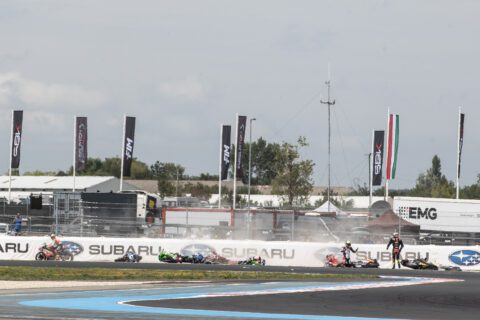

![Shane Byrne, Monstermob Ducati, 2003 WorldSBK, action [Gold & Goose]](https://bikesportnews.com/wp-content/uploads/2025/07/Shane-Byrne-Monstermob-Ducati-2003-WorldSBK-action-Gold-Goose-480x272.jpg)
